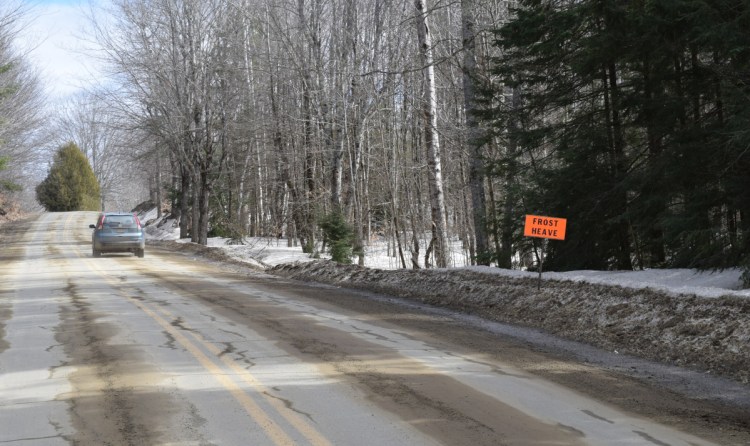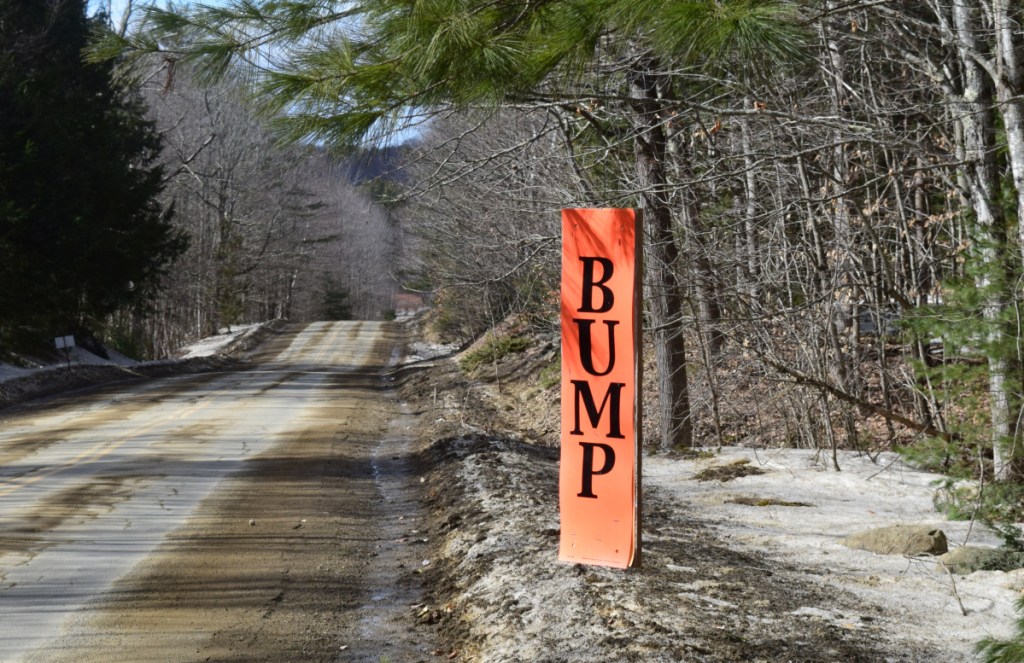Something there is that doesn’t love a road in these parts. Especially in March, when you get the uneasy feeling that winter will never let us out of its jaws.
So many heaves and blast holes appear in paved surfaces at this time of year that the towns stock up on orange “BUMP” signs ahead of time, as if they were amulets that could ward off pothole elves. A stretch of road that was frozen flat and passable in the morning by afternoon appears to have been excavated. Ball joints crack and shock absorbers jounce. But it’s not elves, exactly, it’s that the road is caught in the tug of war between winter and summer. It always feels like winter’s going to win.
It does not like to surrender. Its secret agents are cold and water (which may amount to the same thing), and it uses them in two ways: to create heaves and to create holes.
Frost heaves occur where ice lenses have formed underneath the road. An ice lens is, well, a lens-shaped formation of ice. As winter digs in during December and January, soil and pavement freeze deeper and deeper. Ice fills the cracks and pores. After a certain depth, the soil remains warm enough not to freeze, and at the dividing line between the frozen and unfrozen soil, liquid water below is attracted upward through nooks, crannies and capillaries in the soil to ice pockets above.
How this occurs, exactly, is not conclusively understood. Strange things are happening in the water down there. Some of it is actually “supercooled,” meaning it’s colder than the freezing point, yet still liquid. The supercooled water freezes on contact with the ice pocket, enlarging it. It grows in the shape of a lens and makes the frozen ground swell under the pavement, exerting pressure upward, and then heaves, humps, dips and gaps form in the road that two vehicles can pass abreast. Slowly.
While frost heaves are created from the bottom up, potholes are created from the top down. When ice melts on warmer days, it leaves gaps in the pavement, and liquid water running off the snow and ice seeps in. At night winter seizes its opportunity and drives the temperature down again, icing everything. Freezing water expands naturally by 9 percent in volume, so there’s more ice pushing inside the pavement. When the March sun rises, higher and warmer than it was in February, more ice melts and more moisture gets into the gaps. The pavement expands, contracts, gets stressed by the ice, and cracks. As cars and trucks rumble over, the pavement breaks up and tires kick out pieces and form holes. Heavy trucks are winter’s special allies in demolishing pavement. So there are at least two things that don’t love a road.
The war between winter and summer goes on for what seems like a lifetime every year. Despite the fact the sun is getting higher in the sky, in March the prospects for victory seem bleak, especially on places like Rogers Road in Troy, which before it got repaved a couple of years ago could compete in the Worst Road contest. And lately is returning to its, well, natural state. Some think the world will end in fire, but right now ice seems great and will suffice.
Suffice to bottom out any vehicle that is not a skidder, anyway.
Dana Wilde lives in Troy. You can contact him at naturalist1@dwildepress.net. His recent book is “Summer to Fall: Notes and Numina from the Maine Woods” available from North Country Press. <http://www.northcountrypress.com/summer-to-fall.html> Backyard Naturalist appears the second and fourth Thursdays each month.
Copy the Story LinkSend questions/comments to the editors.




Success. Please wait for the page to reload. If the page does not reload within 5 seconds, please refresh the page.
Enter your email and password to access comments.
Hi, to comment on stories you must . This profile is in addition to your subscription and website login.
Already have a commenting profile? .
Invalid username/password.
Please check your email to confirm and complete your registration.
Only subscribers are eligible to post comments. Please subscribe or login first for digital access. Here’s why.
Use the form below to reset your password. When you've submitted your account email, we will send an email with a reset code.